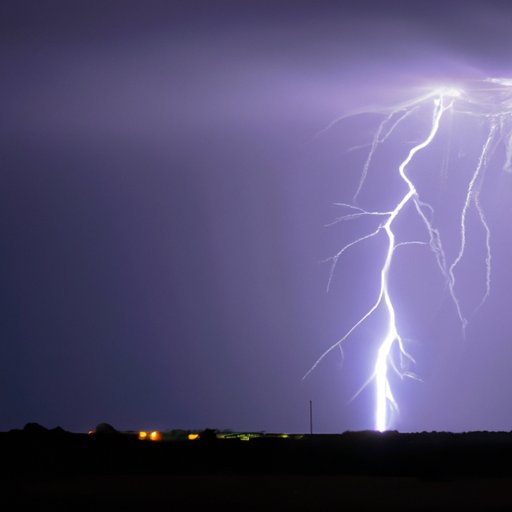
I. Introduction
Thunder and lightning are two natural wonders that often occur simultaneously during a thunderstorm. However, have you ever heard thunder without seeing any lightning? This has been a topic of curiosity among people for centuries. In this article, we will explore the science behind thunder without lightning phenomenon.
Understanding why this topic is relevant is crucial. Thunderstorm can be a dangerous and frightening experience, and knowing what to expect and how to prepare can help you stay safe.
II. Exploring the Science of Thunder: Why Lightning Is Important But Not Always Necessary
First, let’s define thunder and lightning. Thunder is the sound produced by a lightning bolt. Lightning occurs when the charge separation in clouds becomes so large that it produces an electrical discharge, which heats the air around it creating a sudden expansion and contraction, producing a sound wave that we hear as thunder.
Lightning is essential in the formation of thunder, but it is not always necessary. A lightning bolt can take several paths, and it doesn’t always reach the ground. In fact, approximately 80% of lightning occurs within clouds, which doesn’t produce any visible lightning strikes but can still generate thunder.
III. Thunder Without Lightning: The Physics Behind This Phenomenon
So, what conditions must occur for thunder without lightning to occur? Thunder can occur without lightning when the lightning bolt is entirely embedded within the cloud and doesn’t reach the ground. When the lightning bolt is embedded into a cloud, it still creates a sound wave which we hear as thunder.
Sound travels much more slowly than light, so the sound wave takes longer to reach us, making thunder appear to come after lightning. Thunder travels through the atmosphere but is affected by temperature and air pressure. For instance, sound travels faster in warm air than cold air.
IV. Can You Hear Thunder Without Lightning? How Weather Conditions Affect Our Perception
The perception of thunder without lightning can vary depending on weather conditions. Distance and direction play a crucial role in thunder perception. If you’re too far from the storm, you may not hear thunder at all.
Wind and precipitation can also affect how we hear thunder. Strong winds can cause the sound of thunder to become distorted, making it challenging to differentiate it from other sounds. Heavy rainfall can also mask the sound of thunder or make it sound muffled.
The terrain can also affect how we hear thunder. Sound waves can echo off mountains, making thunder sound louder and more prolonged. Conversely, if you are in a flat area, thunder could seem to be less intense.
V. Thunder But No Lightning: Myth or Reality?
It’s a common misconception that thunder never occurs without lightning. Thunder is possible without lightning, although it’s a relatively rare occurrence. Some examples of what can cause thunder without lightning include volcanic eruptions, nuclear explosions, and meteorite impacts.
It’s also possible for thunderstorm clouds to produce thunder without lightning. When charged areas of the cloud move around, they can create electric fields that cause nearby air to expand and contract, producing a soundwave we hear as thunder.
VI. A Closer Look at Thunderstorms: Separating Fact from Fiction
There are many misconceptions about thunderstorms. For instance, it’s sometimes believed that lightning won’t strike the same place twice, but this is not accurate. Thunderstorms often occur in stages, typically starting with cumulus clouds, moving to the mature stage, and ending in a dissipating stage. During the mature stage, storms can produce several lightning strikes.
Thunder and lightning are two phenomena that usually occur together, but not always. Thunder is always a result of lightning, but lightning doesn’t always result in thunder. It’s essential to understand how both natural wonders work together during a thunderstorm.
VII. Thunder and Lightning: Understanding the Relationship Between the Two Natural Wonders
Thunder and lightning are natural wonders that have a complex relationship with one another. Changes in electrical charges in clouds can create lightning and thunder depending on the intensity of the storm.
Lightning and thunder are vital for Earth’s atmosphere as they generate beneficial reactive chemicals such as ozone and nitrogen oxides. These chemicals protect the atmosphere from harmful ultraviolet radiation from the sun.
VIII. Conclusion
The phenomenon of thunder without lightning is a fantastic topic to explore. By understanding the science behind these natural wonders, you can be better prepared for any thunderstorm, including the situation of thunder without lightning.
Knowing how thunder and lightning work together is crucial, not only from a safety perspective but also to appreciate the beauty of these natural wonders. By debunking common myths surrounding thunderstorms, we can enjoy these events for what they are. If you find yourself in a thunderstorm, you should stay indoors and avoid exposed areas.




